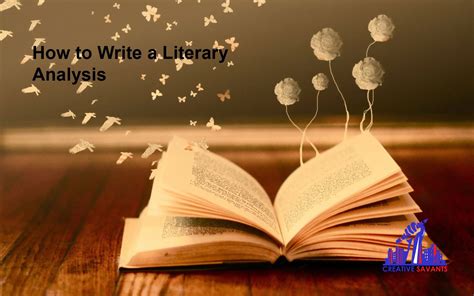What is Analyze in Literature?
Literary analysis is a critical thinking process that involves examining, interpreting, and evaluating literary works to understand their meaning, significance, and impact. It is a systematic approach that enables readers to engage with literature deeply and gain insights into the author’s craft, the characters’ motivations, and the themes and messages conveyed.

Steps Involved in Literary Analysis
The process of literary analysis typically involves several steps:
- Close Reading: Read the text carefully and attentively, paying attention to every detail and nuance.
- Identify Literary Devices: Examine the author’s use of literary devices such as symbolism, metaphor, imagery, and allegory to enhance understanding.
- Analyze Characters: Study the characters’ personalities, motivations, actions, and interactions to uncover their significance and role in the story.
- Explore Setting: Consider the setting and its influence on the characters and events within the narrative.
- Determine Theme: Identify the central themes and messages that the author conveys through the work.
- Formulate Interpretation: Based on the previous steps, formulate an interpretation of the work’s meaning, significance, and relevance.
- Support Argument: Use textual evidence to support and defend your interpretation.
Types of Literary Analysis
There are various approaches to literary analysis, each focusing on specific aspects of the work:
- Formalist Criticism: Emphasizes the text itself, examining its structure, language, and style.
- Structuralist Criticism: Focuses on the underlying structures and patterns that give the work its meaning.
- Marxist Criticism: Analyzes the work’s relationship to economic and social conditions.
- Feminist Criticism: Explores the portrayal of gender and power dynamics in the work.
- Post-Structuralist Criticism: Questions the assumptions and interpretations surrounding the text.
Importance of Literary Analysis
Literary analysis is essential for several reasons:
- Enhances Comprehension: Deepens understanding of the text’s content and message.
- Develops Critical Thinking: Sharpens analytical and evaluative skills.
- Expands Cultural Awareness: Provides insights into different perspectives, values, and beliefs.
- Fosters Empathy: Allows readers to understand and connect with characters and their experiences.
- Appreciates Literary Craft: Reveals the author’s techniques and the artistry of the work.
Applications of Literary Analysis in Education
Literary analysis is widely used in education:
- Teaching Literature: Helps students comprehend and appreciate literary works in depth.
- Developing Critical Thinking: Encourages students to critically evaluate texts and form their own interpretations.
- Improving Writing Skills: Equips students with the analytical and writing skills necessary for literary essays and analysis.
- Fostering Cross-Curricular Connections: Connects literature to other disciplines, such as history, sociology, and psychology.
Tables for Literary Analysis
| Element of Analysis | Definition |
|---|---|
| Characters | Individuals or groups who drive the plot and convey the author’s message. |
| Setting | Physical and temporal context of the narrative. |
| Plot | Sequence of events that shape the story. |
| Theme | Central message or idea explored in the work. |
| Literary Device | Definition | Example |
|---|---|---|
| Symbolism | Use of objects, characters, or events to represent abstract concepts. | The color white often symbolizes purity or innocence. |
| Metaphor | Comparison of two unlike things without using “like” or “as”. | “My love is a raging fire.” |
| Imagery | Use of vivid language to create sensory experiences. | “The wind howled through the barren trees.” |
| Allegory | Narrative that conveys a deeper moral or political meaning. | George Orwell’s “Animal Farm” allegorizes political tyranny. |
| Critical Approach | Focus |
|---|---|
| Formalist | Textual structure, language, and style. |
| Structuralist | Underlying patterns and relationships. |
| Marxist | Relationship to economic and social conditions. |
| Feminist | Gender and power dynamics. |
| Benefits of Literary Analysis |
|—|—|
| Enhances comprehension of the text. |
| Develops critical thinking skills. |
| Expands cultural awareness. |
| Fosters empathy for characters and their experiences. |
| Appreciates literary craft. |
FAQs on Literary Analysis
1. What is the main purpose of literary analysis?
To examine, interpret, and evaluate literary works to understand their meaning, significance, and impact.
2. What are some common types of literary analysis?
Formalist, structuralist, Marxist, feminist, and post-structuralist criticism.
3. What steps are involved in literary analysis?
Close reading, identifying literary devices, analyzing characters and setting, determining theme, formulating interpretation, and supporting argument.
4. How can literary analysis be used in education?
To enhance comprehension, develop critical thinking, improve writing skills, and foster cross-curricular connections.
5. What are some examples of literary devices?
Symbolism, metaphor, imagery, and allegory.
6. What is the difference between theme and motif?
A theme is the central message while a motif is a recurring element or pattern that contributes to the overall meaning.
7. Can literary analysis be used to interpret different types of texts?
Yes, literary analysis techniques can be applied to a wide range of texts, including fiction, non-fiction, poetry, and drama.
8. How do I develop my literary analysis skills?
Regularly engage with literature, critically read and analyze texts, discuss your interpretations with others, and seek feedback from instructors or mentors.
